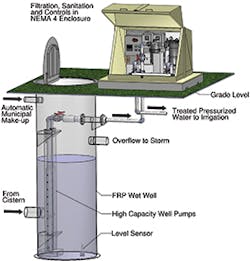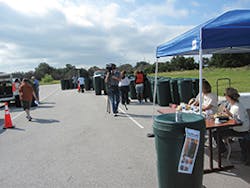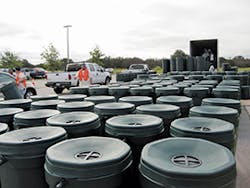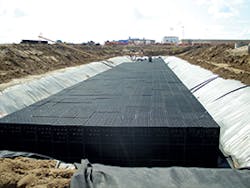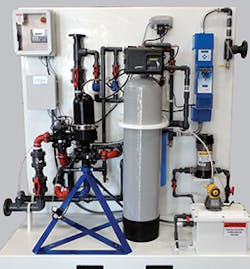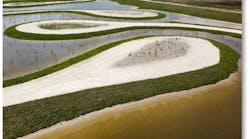Drought Cycles Not New
On January 17, a state of drought emergency was declared in California by Governor Jerry Brown. By early February, snowpack in the Eastern Sierras was at only 12% of its normal level. For many, this declaration did not come as a surprise: In the southwestern US, drought cycles are the norm, never the exception.
But, even by dry standards, the weather in 2013 was unusually warm with little to no rainfall to speak of. Los Angeleans cranked their air conditioners over the Christmas holiday. San Franciscans picnicked in sundresses and shorts in the middle of January. A brief cold spell in December seemed to hint at an oncoming storm, but the rain never came. And, soon the sun was taunting the state again, teasing the many stakeholders who, since the development of the western US, have been embroiled in a battle over scarce water resources.
Farmers, developers, environmentalists, urbanites, and suburbanites jealously eye one another’s allocations, bitterly counting each acre-foot. These battles are exhaustingly familiar to Californians and the residents of other dry western states. The reality of scarcity has always been met with the dream of an Edenic wonderland, a fantasy that is proving harder to maintain. Temperatures are rising globally, and climate scientists predict that droughts will increase overall in severity, and will occur in many places once considered water secure.
According to EPA, at any given point in the last 13 years, anywhere from 30-70% of the continental US was experiencing abnormally dry conditions. NASA reports that 2013 was the fourth hottest year ever recorded worldwide, and nine out of ten of the hottest years overall have occurred since 2000. Climate change is happening at a dramatically faster rate than previously predicted; extreme droughts are undoubtedly going to increase in frequency and intensity. It is imperative that we prepare our communities for the insecure future we face. The big question is: can we depend upon the same water management techniques we have trusted in the past in order to adapt to the problems of the future?
When it comes to water storage, it seems unlikely that we will be able to dam our way out of this problem. Already, most of California’s major reservoirs are at dangerously low levels. Sedimentation and rapid evaporation greatly reduce the quality and quantity of water that remains bound behind the walls of dams. Some dams lose more water annually to evaporation than they make available to users, a loss that simply cannot be justified in a state of emergency. As the water evaporates, salts are left behind, which have to be removed using energy intensive and expensive desalinization technology. Siltation, an unavoidable consequence of damming rivers, creates a problem as inevitable as it is costly.
Estimates predict that within 100 years, Lake Mead, Lake Powell, and a number of other dams in the Western US could be filled entirely with silt from upstream, making these critical reservoirs useless for storing water or producing hydroelectric power. These issues cannot be fixed without vast sums of money, time, energy, and political coordination, all of which seem to be just as scarce as water itself.
Our ability to store the most amount of water in one place for simple, streamlined distribution has also greatly increased our ability to bankrupt the system that we so desperately depend upon.
“Storage has been tremendously helpful to us,” says Peter Gleick of the Pacific Institute, a research and advocacy group based in Oakland, CA. “But we’ve reached a point where creating more storage won’t help us in California. It is time to rethink what we mean by storage.”
Gleick’s most recent publication, The World’s Water, Vol. 8 looks deeply into the question of responsible water management. “There are other possibilities for water storage,” he adds. “The storage options of the future have to be built to higher standards, environmental standards, and efficiency standards.”
Many people are experimenting with new models of water storage and are finding that by reconsidering what they mean by “wastewater,” that they can greatly reduce their water use while effectively storing water for themselves and for future generations.
Rainwater
Rainwater harvesting is becoming one of the most popular water storage alternatives in the US today. Rainwater barrels and cisterns come in a number of sizes, and varying levels of sophistication and can be used to greatly reduce consumption of water treated to potable standards in homes, on farms, and in large buildings and campuses.
“It has never made sense to me why we use highly processed water to dump on our lawns and landscapes,” says Mike Ruck of the American Rainwater Catchment Association, and co-owner of Rain Water Solutions, based out of North Carolina. “Rain barrels and cisterns collect water at the source, water that is otherwise just sent to the curb. Since the water is collected and used on site it reduces the amount of potable water needed and diminishes the dependency on imported water.”
Ruck’s company has worked to provide a number of rain barrels to individuals and municipalities across the country, saving potable water sources 50 gallons at a time in places like Fort Worth, TX; Cedar Rapids, IA; and Oakland. These barrels, which are easy to install and can be used for a number of non-potable uses, collect water that would otherwise run off of roofs, down impermeable streets, and into storm drains.
Without the obtrusive layers of pavement and the construction of buildings, rainwater gradually seeps into soil,
The Pioneer Hybrid Atlantis underground storage system, made of recycled polypropylene crates, which holds 100,000 gallons
feeding plants and organisms, and eventually flowing into aquifers, rivers, and lakes. The vast overlaying of impermeable surfaces on our landscapes halt this process, thus reducing local water recharge. This contributes not only to the depletion of groundwater and native habitat, but also greatly increases flash flooding. Stormwater careens down paved streets and into storm drains, carrying oil, cigarette butts, animal waste, and other toxins off of the streets, eventually landing in energy-intensive treatment plants where it is treated to varying degrees and finally dumped wherever is most convenient.
By collecting rainwater at the source, citizens can play a role in rehabilitating their watersheds and reducing the load on local storm water treatment plants, thus reducing energy use and carbon emissions associated with water treatment and distribution. Though rainwater is generally used for irrigation, people can use their harvested rainwater to wash their dishes and laundry, cool their homes, flush their toilets, and water their lawns and gardens, allowing the water to naturally percolate into the soil, without putting any additional strain on over tapped reservoirs.
These barrels can even be used to provide water during periods of disaster. Rain Water Solutions partnered with an international aid agency to supply shelters in Haiti with rainwater catchment barrels, thus reducing the strain of sourcing water on the people living in shelters. John Bauer of Wahaso Water Harvesting Solutions attests that with proper treatment, stored rainwater could be a perfectly safe source of drinking water.
“We don’t normally think of our systems as disaster relief storage, but many commercial systems hold 10 to 100,000 gallons of rainwater when full,” he says. “While the treatment systems aren’t designed to provide certified drinking water, the water would be quite safe to use for washing or even drinking in a disaster.”
Wahaso has installed these massive commercial systems, which can each save on average 1–3 million gallons of water per year, in grocery stores, hotels, Marine Corps facilities, and municipal water districts across the country. Wahaso specializes in onsite rainwater and graywater harvesting, treatment, and distribution, with an emphasis on holistic design. Designers meet with clients to assess their specific site’s water sources and needs in order to enhance the efficiency and effectiveness of each unique system. Wahaso recently collaborated on the building of a new Whole Foods in Brooklyn, NY, designing a system that collects graywater from store lavatories and cooling units, as well as rainwater from the rooftop and solar car shades into a single system that distributes the water either into flush toilets, or into the surrounding landscaped areas.
The greywater skid installed in the Brooklyn Whole Foods
“We have also designed systems that harvest the discharge water from reverse osmosis systems, from commercial rinse systems, and more,” says Bauer. “In many cases, it just takes creativity to bring together all available sources and to design a single processing system that can handle different levels of contaminants.”
The ability to reuse graywater is a key aspect in this conservation equation.
Graywater and Groundwater Recharge
Graywater can meet many water needs in places where rainwater is scarce or unreliable, though it generally is not recommended that one store graywater, as it’s quality decreases much more quickly than clean water, unless treated to a high standard before storage. Nonetheless, every gallon of graywater diverted into gardens, orchards, and lawns preserves a gallon of potable water for future use. And a long-view perspective reveals that by diverting graywater from the pipe into the garden, one is contributing to future water security by allowing the water to percolate through the soil and into underground basins and deep aquifers where it can be stored indefinitely. This sort of long-view perspective may be just what has been missing from our water management as a whole. When we take the needs of future generations into account, the wastefulness of our systems become garishly apparent.
For Brad Lancaster, a permaculturalist and author of Rainwater Harvesting for Drylands and Beyond, sustainable water management hinges on a central belief that there is no such thing as wastewater.
“Why do we even have the term wastewater? In nature there is no such thing as waste!” he remarked at a recent talk in San Francisco, CA.
Xerxes Corporation, a ZCL Company, recognizes that due to contaminants that become mixed with rain, many communities now require a specific retention time before allowing stormwater to run into a drainage system. This is especially true in areas with very little green space available. Typically, retention ponds are used to meet this requirement. Xerxes underground and aboveground fiberglass storage tanks offer an alternative and may qualify for credits from the United States Green Building Council’s latest version of the LEED rating system. Within the Sustainable Sites (SS) category, the Rainwater Management credit (SSC4) offers points depending on the quantity of rainfall collected on an annual basis and how it is used. While meeting retention-in-time requirements, developers and property owners can also make better use of property by locating stormwater tanks in parking lots, inside buildings, or underneath parking areas as a result of having the option of an aboveground or underground storage tank.The collected stormwater can also be used for nonpotable applications such as landscape irrigation, which may allow for LEED Water Efficiency credits (Credit WEp2 and Credit WEc1). These credits are designed to reduce outdoor water consumption. A popular way to achieve these credits is through using captured water to irrigate athletic fields within school districts and communities.In addition to water and wastewater fiberglass storage tanks, Xerxes offers an oil/water separator solution for applications where significant cleaning of water is required.
For Lancaster, resilient systems store, use, and reuse water infinitely by allowing it to recharge natural basins. Through permacultural tinkering, Lancaster has proven that abundance can exist in the desert without importing mass amounts of water, but instead by storing his rainwater, graywater, and stormwater runoff in tanks and vegetated basins.
Born and raised near Tucson, AZ, Lancaster grew up drinking water from an over tapped aquifer. As an adult, he traveled the world studying sustainable design and agriculture, and eventually came back to Tucson with a new understanding of ecology and renewable water systems. Starting with the block on which he lived, Lancaster began harvesting water using rainwater barrels, earthen basins, and bioswales in his own yard, and was able to maintain a productive vegetable garden, as well as a number of fruit trees, without additional irrigation.
Lancaster began working with his neighbors to change the way water was used on their street. They clandestinely cut into their curbs to funnel stormwater into vegetated basins without permission from the city, creating urban swales where stormwater would collect to feed native plants and fruit trees that the neighbors planted. They successfully enhanced the beauty of the street while increasing wild habitat and food availability without requiring any water inputs from Tucson’s tapped system. In fact, they are reducing the load of stormwater runoff and increasing overall recharge into the aquifer below by slowing the water down and allowing it to recharge into the soil naturally.
As they witnessed the transformation of their street, Lancaster and his neighbors began lobbying city officials for municipal water reform. They have succeeded on a number of fronts, from getting the city to legalize curb cuts, to persuading the Arizona State Legislature to pass a tax credit along to homeowners who install water conservation systems into their homes.
These changes are apparent on the streets of Tuscon, where vegetated swales are popping up on numerous street corners and rainwater barrels on the sides of many businesses. Through creativity, scientific study, community building, and political savvy, Brad Lancaster has seen large-scale results from seemingly small-scale solutions.
Lancaster attests that he is able to harvest 100,000 gallons of water per year on his 1/8-acre lot in the desert where, on average, only 11 inches of rain fall per year, capturing most behind handmade dams and swales. Some is funneled and stored in a 1,200-gallon ferrocement (reinforced concrete) tank that sits on the side of his house.
“More rain falls on Tuscon every year than is used by the city,” he says.
Even rainwater, considered the purest source of fresh water, can contain contaminants that make it unsuitable for potable, or even non-potable, uses after it runs off of a rooftop or paved street. Leaf debris, dust, salts, animal droppings, and industrial pollutants, can build up on rooftops, and the roofing material itself can drastically impact the quality of the water running off of it. Pathogens and pests, such as mosquitos, can enter the system if a catchment tank is designed poorly and not filtered and cleaned regularly. Oils and other potentially toxic chemicals can hitch rides on water molecules, flowing from the street into barrels, soils, and, eventually, aquifers. Harvested rainwater ought to be treated to whatever extent is most appropriate for its intended use. Anyone living off of well water can tell you that these are not new issues; protection against contamination is key consideration when designing any water harvesting system, especially if the water is destined for human consumption.The first key to safety when it comes to harvesting rainwater is investing in a good filter that will remove debris before it enters the barrel. Keeping leaves and dirt out of the system not only reduces the amount of cleaning and maintenance one will have to do, but it also prevents aerobic bacteria from building up and consuming all of the dissolved oxygen in the water.This level of filtration ought to be sufficient if you’re sending the runoff directly into the garden. Healthy soils are one of the best filtration devices on earth as water moves through layers of soil different pollutants are absorbed by soil particles on the way. Plants thrive on pure rainwater, which contains no chlorine or other potentially harmful chemicals used for treatment. If rainwater will be used for household or commercial purposes, it ought to be filtered through a fine screen as well in order to prevent grit from clogging pipes and appliances. You may also choose to treat the water with chemicals or UV light in order to kill potential pathogens. A potable system must be much more carefully constructed and must take into account every surface the water will have come into contact with—the roof, the barrel, and the pipes used to transport the water—in order to ensure no toxins are carried along with it.
Though soil does wonders removing certain contaminants from runoff, considerably polluted water ought to be filtered more extensively before being discharged into the environment in order to ensure the health of our waterways and groundwater basins. Oil and water separators have been developed in order to treat rainwater that runs off of car washes, parking lots, and other polluted areas that contain heavy loads of oil. Runoff can be collected and pumped through either an above or underground separator. As the water settles, oils float to the top while heavy sediments sink to the bottom of the tank, and both are filtered out before water is discharged.
“[After treatment] the stored rainwater can then be purified if used for potable applications or left untreated for non-potable uses, like landscape irrigation,” says David Heiman of Containment Solutions.
Containment Solutions specializes in above and underground oil/water separator tanks that work with either gravity-based or pumped flow operations. The low-maintenance separators feature 10- or 15-ppm effluent discharge. The ability to take water from being heavily polluted to potable will no doubt be key as we deal with industrial waste in a water-scarce society.
The opportunities for harvesting, reuse, and groundwater recharge are astounding. “The Santa Cruz river once ran year round through Tucson. People drank from artesian wells and streams…. Now we live with droughts and floods.”
Lancaster attributes this immeasurable loss to what he calls “degenerative infrastructure, which destroys that which it consumes.”
A prime example is our use of groundwater wells, which for centuries have been drying up from overuse across the US. Water is pumped at a faster rate than it can be recharged, creating innumerable problems for communities based on steady groundwater flows. Regenerative infrastructure, on the other hand, takes a holistic approach, in which systems are designed to mimic dynamic natural cycles, where wastewater is reused and recharged into underground aquifers and other natural water basins.
Groundwater management is certain to be the next big topic when it comes to water storage and reuse. While Lancaster and his neighbors are working to reduce impermeable surfaces in their community, opening up swaths of land that allow for the slow recharge of their groundwater, whole water districts are looking into storing treated wastewater in their depleted aquifers for future use. In one of the densest urban centers in southern California, Orange County’s wastewater treatment plant also acts as a groundwater replenishment system, allowing treated wastewater to be tapped once again as potable drinking water. Their system is proving that this approach can be taken on a large scale, with the hope of ensuring water availability for generations to come.
The success of Lancaster’s work pushes us to reshape of our ideas of waste. The prevailing philosophy behind water management for many years has assumed that allowing water to flow naturally through streams, wetlands, and into the soil was wasting water that could be used for human consumption. We are beginning to understand that pulling water out of its natural course to use once and then discard is the truly wasteful system.
It’s true that storing water in rain barrels and native food gardens assumes a different philosophy about resource management in general. Much of what Lancaster eats is grown on his property and in his neighborhood and is fed by native water sources. He uses ingenuity and small-scale design to work with the natural world in order to provide for himself and his community, instead of trading his time for cash with which to buy imported food and water. In his world, water is not holed up in one place just waiting to be doled out to the highest bidder. Instead, it permeates its watershed, available to be tapped by all users, human and non-human.
Agriculture and urban development inevitably look different within this framework, where growth is naturally limited to that which can be sustainably supported. It begs an important and timely question: what is better for our society, unlimited growth with the constant threat of precarious collapse, or small-scale resilience with diversified means of providing for one another? Philosophical conundrums aside, it is at least apparent that we can greatly reduce our dependence on imported potable water now in order to ensure storage security in the future, no matter what site or scale we are working with using techniques and technologies both high-tech and low.
